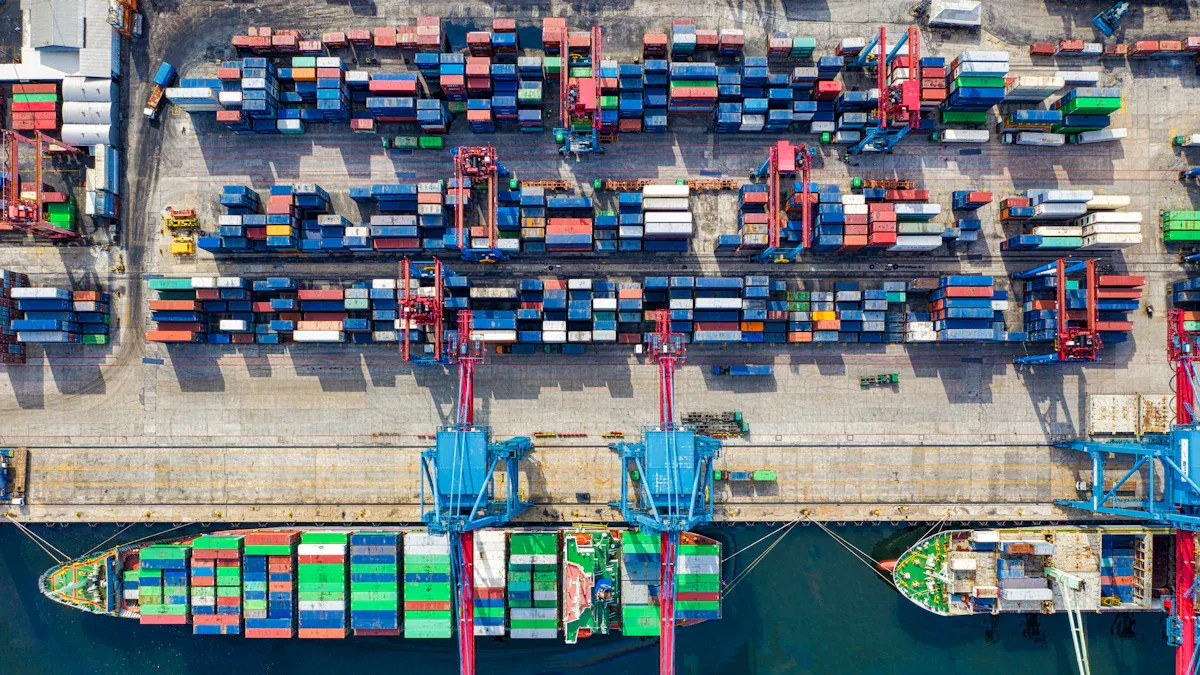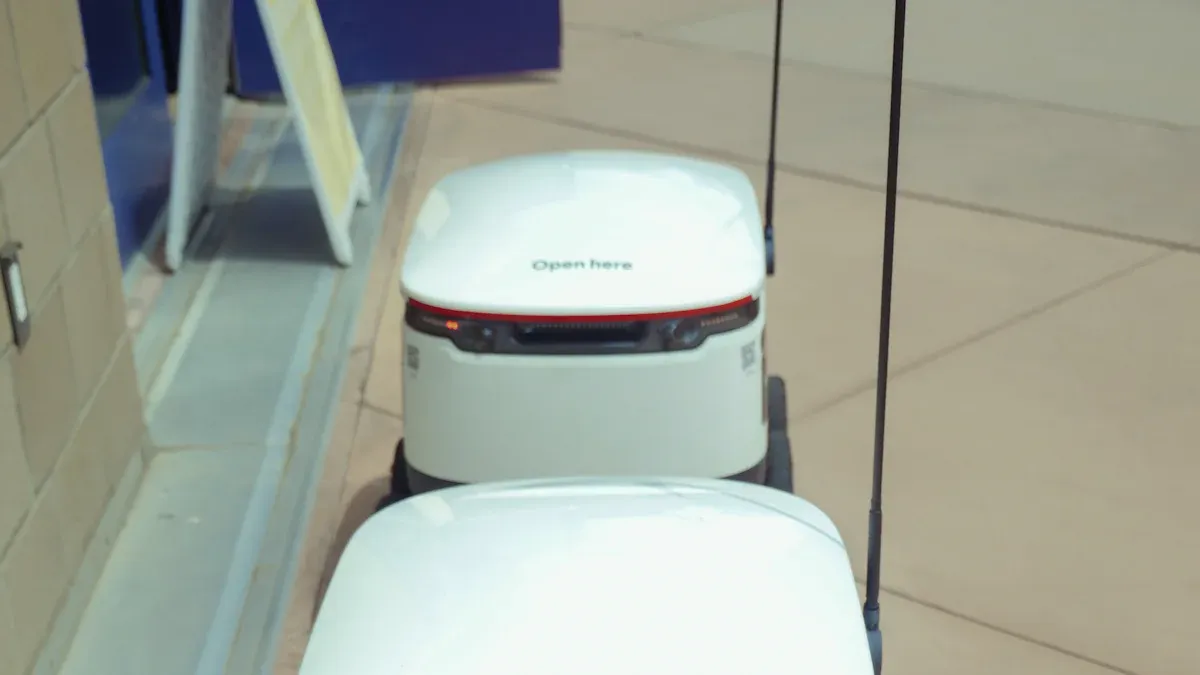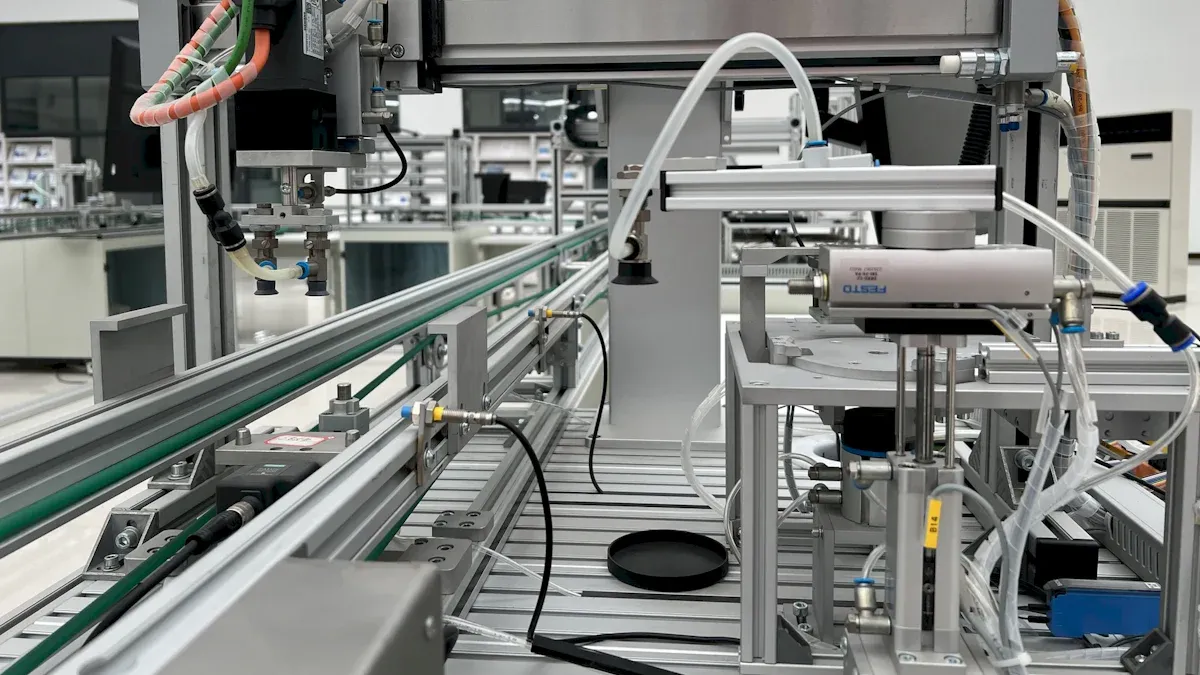From Automation to Intelligence: Evolution of the Smart Supply Chain

Supply chains have undergone a remarkable transformation. They moved from simple automation to intelligent systems that redefine how businesses operate. Intelligent automation improves weekly forecast accuracy by 8%, while monthly forecasts see a 2% boost. Machine automation levels are expected to double in five years, and investments in industrial IoT platforms are projected to grow at a compound annual rate of 40%.
Smart technologies like artificial intelligence, IoT, and blockchain enable supply chains to achieve unprecedented efficiency. By 2033, the AI in Supply Chain market will reach USD 157.6 billion, proving its critical role in shaping the modern Smart Supply Chain.
Key Takeaways
Moving to a Smart Supply Chain makes work faster and flexible. It helps businesses react quickly to market changes.
Using AI and machine learning makes it easier to predict demand. This helps match inventory to customer needs and cut down waste.
IoT devices give real-time data, making it easier to see what’s happening. They help make quick decisions in shipping and inventory.
Blockchain technology keeps things clear and safe. It builds trust with customers by proving where products come from.
Big data tools find patterns and improve how things work. This makes the supply chain run better and more smoothly.
Understanding the Smart Supply Chain
Defining Automation in Supply Chains
Automation in supply chains refers to using technology to perform repetitive tasks with minimal human intervention. It focuses on streamlining processes like inventory management, order fulfillment, and transportation. For example, automated material handling systems, such as conveyor belts and robotic arms, improve efficiency in warehouses.
Automation also enhances planning capabilities by providing real-time visibility into data. This allows you to make better decisions about resource allocation and demand forecasting. A supply chain technician plays a key role in maintaining these systems, ensuring they operate smoothly to support your business goals.
Definition | Description |
|---|---|
Supply Chain Technician | A person who installs, operates, supports, upgrades, or maintains automated material handling equipment and systems. |
What Makes a Supply Chain Intelligent?
An intelligent supply chain goes beyond automation by incorporating advanced technologies like artificial intelligence (AI), the Internet of Things (IoT), and big data analytics. These technologies enable the supply chain to learn, adapt, and make decisions autonomously. For instance, intelligent systems can restructure networks during disruptions, ensuring minimal impact on operations.
Key characteristics of an intelligent supply chain include being instrumented, interconnected, and adaptable. Advanced monitoring devices and analytics models analyze real-time and historical data, helping you optimize decision-making. This level of intelligence reduces costs and enhances collaboration across the supply chain.
Intelligent supply chains autonomously learn and adapt.
Advanced analytics improve outcomes and reduce operational costs.
Smart technologies enhance collaboration and transparency.
Key Differences Between Automation and Intelligence
Automation and intelligence serve different purposes in the supply chain. Automation focuses on efficiency by performing repetitive tasks, while intelligence emphasizes adaptability and decision-making. Automated systems rely on predefined rules, but intelligent systems use data and algorithms to predict outcomes and respond to changes.
Aspect | Automation | Intelligence |
|---|---|---|
Focus | Efficiency and speed | Adaptability and decision-making |
Technology | Basic tools like robotic arms and conveyor belts | Advanced tools like AI, IoT, and big data analytics |
Decision-Making | Rule-based | Data-driven and predictive |
Adaptability | Limited | High |
By transitioning from automation to intelligence, you can create a Smart Supply Chain that is not only efficient but also resilient and forward-thinking.
Technologies Powering the Smart Supply Chain

Artificial Intelligence (AI) and Machine Learning
Artificial Intelligence (AI) and Machine Learning (ML) are revolutionizing how you manage supply chains. These technologies analyze vast amounts of data to predict outcomes, optimize operations, and make informed decisions. For example, machine learning models can evaluate historical data to help you anticipate demand, reduce waste, and improve logistics planning. This predictive capability ensures that your supply chain remains agile and responsive to changes.
AI also plays a critical role in automating complex tasks. By 2028, Gartner predicts that 25% of KPI reporting will rely on generative AI models, while intelligent robots will outnumber frontline workers in industries like manufacturing and logistics. These advancements allow you to focus on strategic planning rather than manual processes, giving your business a competitive edge.
Source | Findings |
|---|---|
Gartner | By 2028, 25% of KPI reporting will use GenAI models, and intelligent robots will outnumber frontline workers. |
Grand View Research | AI helps businesses mitigate disruptions by analyzing real-time data and suggesting proactive measures. |
By integrating AI and ML into your operations, you can transform your supply chain into a proactive, data-driven system that adapts to challenges with ease.
Internet of Things (IoT) for Real-Time Connectivity
The Internet of Things (IoT) connects devices, vehicles, and systems across your supply chain, enabling real-time data sharing and monitoring. This connectivity improves visibility, helping you track shipments, monitor inventory, and address potential issues before they escalate. For instance, IoT sensors in logistics vehicles provide real-time updates on location and condition, ensuring that goods arrive on time and in optimal condition.
IoT also enhances efficiency by addressing common challenges like labor shortages and supply chain blind spots. According to Matt Mathai, IoT and predictive analytics have transformed industries like food production by reducing waste and improving operational efficiency. Additionally, IoT connectivity has been shown to increase traceability speed by 64% and reduce counterfeit incidents by 28%.
Metric | Improvement Percentage |
|---|---|
Traceability Speed | 64% |
Reduction in Counterfeit Incidents | 28% |
By leveraging IoT, you can create a Smart Supply Chain that operates with precision and transparency, ensuring better outcomes for your business and customers.
Blockchain for Transparency and Security
Blockchain technology ensures transparency and security in your supply chain by creating a decentralized, tamper-proof record of transactions. This system eliminates intermediaries, reducing the risk of fraud and manipulation. Each transaction is validated collectively through a consensus mechanism, ensuring that no single entity can alter the data.
For example, OpenSC, a platform developed by WWF Australia and BCG Digital Ventures, uses blockchain to track products throughout their supply chain. By scanning a QR code, consumers can access a product's history, verifying its ethical and sustainable sourcing. This level of transparency builds trust with your customers and strengthens your brand reputation.
Technology | Impact on Supply Chain |
|---|---|
Blockchain | Enhances transparency, security, and efficiency |
IoT | Provides real-time data and tracking capabilities |
AI | Optimizes operations and decision-making processes |
Blockchain also protects sensitive information through encrypted data and distributed ledgers. These features ensure that your supply chain remains secure while fostering collaboration among stakeholders. By adopting blockchain, you can enhance trust, reduce risks, and streamline operations in your Smart Supply Chain.
Big Data and Predictive Analytics in Decision-Making
Big data and predictive analytics are transforming how you make decisions in supply chain management. These tools analyze vast amounts of information to uncover patterns, predict trends, and optimize operations. By leveraging these insights, you can create a more agile and efficient supply chain.
Predictive analytics helps you anticipate demand by identifying patterns in historical data. For example, it can analyze seasonal trends, customer preferences, and market conditions to forecast future needs. This allows you to optimize sourcing and inventory management, ensuring that you have the right products at the right time. Advanced analytics also improve operational efficiency by determining the best routes and processes, reducing costs and resource usage.
Did you know? A top-10 domestic brewery used predictive analytics to enhance its production insights. Initially overwhelmed by data, the brewery achieved savings of up to $800,000 within 18 months. It also reduced operational costs by $300,000 annually through better decision-making.
Big data also increases transparency across your supply chain. By analyzing data from multiple sources, you can track shipments, monitor supplier performance, and ensure sustainable practices. This level of visibility helps you make informed decisions and build trust with your stakeholders.
Here are some key benefits of using big data and predictive analytics in your supply chain:
Improved Demand Forecasting: Identify patterns in large datasets to predict customer needs accurately.
Operational Efficiency: Optimize routes and processes to minimize costs and resource usage.
Enhanced Transparency: Gain insights into every stage of the supply chain for better decision-making.
By integrating big data and predictive analytics into your operations, you can transform your supply chain into a proactive and data-driven system. These tools are essential for building a Smart Supply Chain that adapts to challenges and seizes opportunities.
Benefits of Transitioning to a Smart Supply Chain
Boosting Operational Efficiency
Transitioning to a Smart Supply Chain significantly improves operational efficiency. Smart technologies streamline processes, reduce delays, and enhance productivity. For example, integrating AI-driven systems allows you to automate repetitive tasks, freeing up resources for strategic activities. IoT-enabled devices provide real-time data, helping you monitor inventory levels and optimize logistics routes.
Smart technologies also improve flexibility, enabling you to adapt quickly to changing market demands. By analyzing data patterns, predictive analytics can identify bottlenecks and suggest solutions, ensuring smooth operations. The following table highlights key areas where smart technologies enhance operational performance:
Improvement Area | Evidence |
|---|---|
Productivity Performance | |
Cost Performance | Smart technology minimizes unnecessary external surcharges, leading to better operational cost performance. |
Quality Performance | Integration of smart technology maintains product quality while improving efficiency in the supply chain. |
Operational Flexibility | Smart technologies enhance supply chain capabilities and operational flexibility, enabling innovative solutions. |
By leveraging these advancements, you can create a supply chain that operates efficiently, adapts to challenges, and delivers consistent results.
Enhancing Transparency and Trust
A Smart Supply Chain fosters transparency and builds trust among stakeholders. Technologies like blockchain and IoT provide detailed insights into every stage of the supply chain, ensuring accountability and traceability. For instance, blockchain creates tamper-proof records of transactions, allowing you to verify the authenticity of products and their ethical sourcing.
Many companies have already seen the benefits of transparency. Patagonia, known for its commitment to sustainability, shares detailed information about its supply chain. A report shows that 72% of consumers prefer purchasing from transparent brands. In 2020, Patagonia experienced a 25% revenue increase due to its ethical practices. Similarly, Unilever’s "Sustainable Living Plan" demonstrates that consumers are 4.1 times more likely to trust transparent brands. Unilever’s sustainable products account for over 60% of its growth, with a 69% higher growth rate compared to other products.
Patagonia: Transparency led to a 25% revenue increase in 2020.
Unilever: Sustainable brands grew 69% faster than the company’s overall growth rate.
By adopting smart technologies, you can enhance transparency, build trust, and strengthen your brand reputation.
Driving Sustainability and Environmental Impact
Smart Supply Chains play a crucial role in driving sustainability and reducing environmental impact. Technologies like IoT and AI optimize resource usage, minimize waste, and monitor environmental data. For example, IoT sensors track energy consumption and emissions, helping you identify areas for improvement. Predictive analytics also enable better planning, reducing overproduction and unnecessary transportation.
Research highlights the environmental benefits of Smart Supply Chains. Ciccullo et al. (2018) emphasize how effective sustainable supply chain management (SSCM) systems maximize resource efficiency and minimize ecological impact. Wei (2021) explores recycling procedures and their role in reducing waste. However, Oláh et al. (2020) caution that while smart factories optimize production, the energy demands of sensors and equipment may increase emissions.
Note: Smart technologies improve sustainability but require careful management to balance energy consumption and environmental benefits.
By implementing sustainable practices and leveraging smart technologies, you can reduce your carbon footprint, meet regulatory requirements, and contribute to a greener future.
Real-World Applications of Smart Supply Chains

AI-Driven Demand Forecasting
Artificial intelligence transforms demand forecasting by analyzing vast datasets to predict customer needs with remarkable accuracy. Traditional methods often struggle to account for complex factors like market trends and consumer behavior. AI-driven forecasting overcomes these limitations, enabling you to align inventory levels with demand effectively. For instance, Zara uses AI to tailor its design and delivery processes based on consumer preferences. By analyzing user feedback and social media trends, Zara stays ahead of the curve, offering products that resonate with its audience.
AI also optimizes supply chain logistics. It integrates data from multiple sources, providing actionable insights that improve inventory turnover and reduce waste. Real-time insights help you manage raw materials and production schedules, ensuring you meet demand without overstocking. This approach not only enhances customer satisfaction but also lowers storage costs and minimizes environmental impact.
IoT-Enabled Logistics and Fleet Management
The Internet of Things (IoT) revolutionizes logistics by connecting vehicles, devices, and systems for real-time monitoring. Predictive maintenance, powered by IoT, reduces downtime by 25% and extends vehicle lifespan by 20%. Real-time tracking ensures safe driving practices, reducing accidents and improving delivery times by up to 25%.
“Since adding predictive analytics to our fleet, we’ve reduced downtime by 25% and saved $2,000 per vehicle annually.” – Director of Operations, Fortune 500 Logistics Firm
IoT also optimizes fuel usage and routing, cutting fuel waste by 15-20%. These advancements enhance operational efficiency, making your supply chain more reliable and cost-effective.
Blockchain for Ethical Sourcing and Compliance
Blockchain ensures ethical sourcing by creating transparent, tamper-proof records of transactions. Ford uses blockchain to track cobalt from certified mines to battery manufacturing, verifying material provenance and ensuring compliance with ethical standards. Renault employs blockchain to monitor product carbon footprints and support recycling initiatives, reinforcing its ESG goals.
Company | Application Description | Impact on Ethical Sourcing |
|---|---|---|
Ford | Tracks cobalt sourcing | Ensures compliance with ethical standards |
Renault | Tracks carbon footprints | Supports recycling and circular economy goals |
Blockchain also reduces non-compliance expenses by 50% and enables near-instant validation of certifications. By adopting blockchain, you can enhance transparency, build trust, and meet regulatory requirements in your Smart Supply Chain.
Preparing for the Future of Smart Supply Chains
Emerging Trends in Supply Chain Technology
The future of supply chains lies in adopting cutting-edge technologies that enhance efficiency and adaptability. Emerging trends highlight how innovation is reshaping operations. For example, ambient invisible intelligence enables real-time visibility by leveraging affordable tracking and sensing tools. This trend ensures you can monitor your supply chain seamlessly. Similarly, augmented connected workforce digitizes standard procedures, improving decision-making accuracy and productivity.
Other advancements include polyfunctional robots, which perform multiple tasks in warehouses, and agentic AI, which autonomously executes decisions to boost efficiency. Autonomous data collection through drones and robots reduces labor needs while improving productivity. These technologies, combined with decision intelligence and intelligent simulation, enhance predictive capabilities and streamline operations.
Trend | Description |
|---|---|
Ambient Invisible Intelligence | Enables real-time visibility into supply chains through affordable tracking and sensing technologies. |
Augmented Connected Workforce | Improves decision accuracy and productivity by digitizing standard operating procedures. |
Polyfunctional Robots | Provides flexible workforce solutions by performing multiple tasks in warehouses. |
Agentic AI | Enhances adaptability and efficiency by autonomously executing decisions in supply chain operations. |
Autonomous Data Collection | Uses drones and robots for data capture, improving productivity and reducing labor. |
Decision Intelligence | Combines AI and analytics to support and automate decision-making processes. |
Intelligent Simulation | Enhances predictive capabilities in logistics and warehouse operations through AI integration. |
Steps for Businesses to Embrace Smart Supply Chains
Transitioning to a Smart Supply Chain requires a strategic approach. Start by mapping and analyzing your processes to identify inefficiencies. Use Kaizen events to implement continuous improvements. Optimize inventory with just-in-time models to reduce waste and improve resource allocation. Big data analytics can help you predict demand and optimize logistics.
Integrating IoT devices allows real-time data collection, while AI and machine learning improve routing and inventory management. For instance, Company A reduced costs by 18% after adopting AI-driven inventory management. Similarly, Company B enhanced customer satisfaction and increased sales by 12% through real-time analytics.
Key Strategies for Supply Chain Optimization:
Process mapping to uncover redundancies.
Kaizen events for continuous improvement.
Just-in-time inventory models.
Big data analytics for demand prediction.
IoT devices for real-time monitoring.
AI and machine learning for smarter routing.
Overcoming Challenges and Seizing Opportunities
Adopting smart technologies comes with challenges, but they also present opportunities. Research highlights the need for more studies on implementing Industry 4.0 technologies to address supply chain issues. For example, the study "Opportunities and Challenges of Smart Supply Chain in Industry 5.0" provides a framework for overcoming obstacles like high implementation costs and data security concerns.
Opportunities include improving workforce safety through predictive maintenance and enhancing sustainability by reducing waste. Automated logistics operations and smart spare parts management also streamline processes, enabling just-in-time ordering and reducing stale inventory. By addressing challenges proactively, you can unlock the full potential of a Smart Supply Chain.
Study Title | Focus | Methodology | Findings |
|---|---|---|---|
Opportunities and Challenges of Smart Supply Chain in Industry 5.0 | Analyzes SSC opportunities and challenges in the context of Industry 5.0 | Delphi method | Provides a conceptual framework for smart supply chains based on Industry 5.0, identifying key opportunities and challenges. |
Supply Chains and Artificial Intelligence: An Approach to the State of the Art | Examines the impact of AI and data analytics on supply chains | Data analytical methods | Highlights the need for more studies on implementing Industry 4.0 technologies to address supply chain challenges. |
The journey from automation to intelligence has transformed supply chains into dynamic, adaptive systems. By integrating AI-driven insights with human expertise, you can achieve real-time visibility and control, enabling faster responses to demand changes. Technologies like predictive analytics and machine learning have shifted operations from rigid processes to intelligent networks that optimize decisions dynamically.
Adopting a Smart Supply Chain enhances efficiency, transparency, and sustainability. It empowers you to predict demand, optimize inventory, and streamline logistics. Businesses that embrace these advancements position themselves for long-term success. Proactively adopting emerging technologies ensures you remain competitive in an ever-evolving market.
FAQ
What is the difference between a smart supply chain and a traditional one?
A smart supply chain uses advanced technologies like AI, IoT, and blockchain to optimize operations. Traditional supply chains rely on manual processes and basic automation. Smart systems adapt to changes, predict outcomes, and improve efficiency, while traditional ones often struggle with flexibility and real-time decision-making.
How can small businesses benefit from smart supply chains?
Small businesses can use smart technologies to reduce costs, improve inventory management, and enhance customer satisfaction. For example, IoT devices provide real-time tracking, while AI-driven analytics help predict demand. These tools make operations more efficient and competitive, even with limited resources.
Are smart supply chains environmentally friendly?
Yes, smart supply chains promote sustainability. Technologies like IoT monitor energy use, while AI optimizes routes to reduce fuel consumption. Predictive analytics prevent overproduction, minimizing waste. These innovations help you lower your carbon footprint and meet environmental goals.
What challenges might you face when adopting smart supply chain technologies?
You may encounter high implementation costs, data security concerns, and a need for skilled personnel. Start small by integrating one technology, like IoT, and gradually expand. Training your team and partnering with experts can also help overcome these challenges.
How do smart supply chains improve customer satisfaction?
Smart supply chains ensure faster deliveries, accurate order tracking, and better product availability. AI-driven demand forecasting prevents stockouts, while IoT-enabled tracking keeps customers informed. These improvements build trust and enhance the overall customer experience.
See Also
Transforming Data Obstacles into Opportunities with Atlas and Singdata
Effective Strategies for Weekly Retail Demand Forecasting
Understanding the Differences Between Omnichannel and Multichannel

